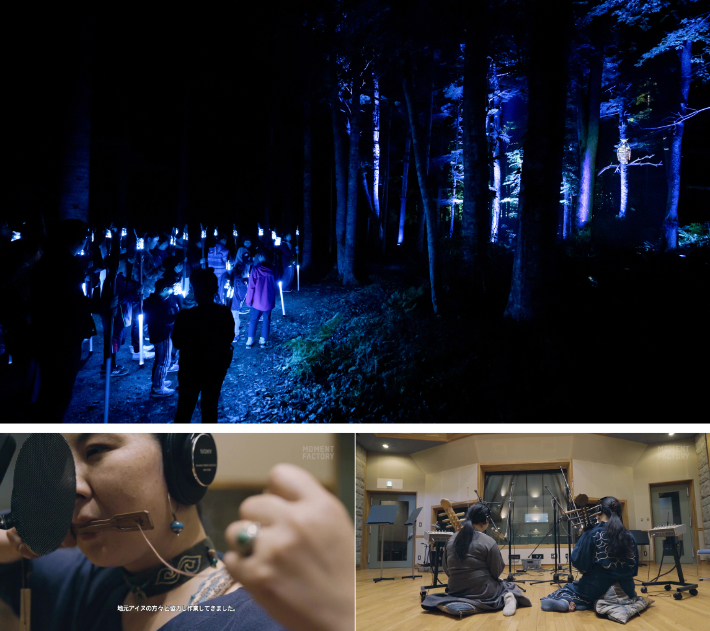Of all the indigenous people of Japan, the Ainu are arguably the most well recognized throughout both the Japanese and international communities, and yet despite that, so little is really known about them.
Although once the main population of Japan, the arrival of the migrating Yayoi people around 300 BC would force the Ainu northwards toward Tohoku, Hokkaido and the former Japanese islands of Karafuto. Already a disappearing culture, the Meiji restoration and the forced implementation of modern society that it brought with it would further threaten the Ainu during the 19th century; and now, only a handful of pockets remain on the island of Hokkaido that are dedicated to the preservation of Japan’s first civilized people.
On the shores of Hokkaido’s Lake Akan, Akanko Ainu Kotan is one of the few settlements remaining on the island that is committed to the protection, revitalization and continuation of Ainu culture. The settlement consists of 36 residences and is home to about 120 people.
At Akanko Ainu Kotan, visitors can experience a variety of crafts and performances that provide a glance into the life of Ainu. However, there is one experience in particular that we believe shouldn’t be missed – the Akanko no Mori Night Walk Kamuy Lumina.
An interactive nature-based experience that combines the surrounding environment with digital technology, immersive sound and projection mapping, the Akanko no Mori Night Walk Kamuy Lumina is designed to bring participants closer to the culture and beliefs of the Ainu than they’ve ever been able to be before.
Held every night from spring through to autumn, the Akanko no Mori Night Walk Kamuy Lumina is a fully immersive entertainment experience produced in collaboration with international multimedia studio Moment Factory.
Through the use of digital art, sounds, music and projection mapping, the event allows visitors to participate in an Ainu saga that conveys the importance of "coexisting with nature”. The event can be enjoyed by both children and adults alike, who, once immersed in the story, can experience the world of Ainu and the natural beauty of Lake Akan with all five senses.
Participants are given a “rhythm stick” which is used as a guide along the 1.2km forested promenade that the event is set up at. This stick is made to resemble the appearance of traditional canes used by the Ainu when they would journey through the mountains and forests. Complete with a GPS tracker, speaker and light, the rhythm stick is essential to the experience and provides participants with story dialogue, narration and music alongside illumination to guide the way through the dark forest.

The story played out at Akanko no Mori Night Walk Kamuy Lumina is based on the Ainu saga “The Story of the Jay God who saved people from the Great Famine”, which has been passed down through generations as a traditional Ainu "ikor."

Akanko no Mori Night Walk Kamuy Lumina will be held every night from May 14 through to Nov 14.
*As the story draws on the importance of nature, the event will continue even during rainfall. In the case of rain, the use of umbrellas is not permitted, because of this, it is best to dress appropriately with waterproofs and non-slip rain boots.
Venue: Bokke Promenade, Akan Mashu National Park
Time: Performances begin 30 minutes after sunset, which will vary depending on the season. Stay up-to-date with seasonal time updates via the official ticketing website.
Performance time: Approximately 50 minutes
Tickets
Advance Adults (Junior High and above): 3,000 yen
Advance Children (Elementary School): 1,500 yen
Same-day Adults: 3,500 yen
Same-day Children: 1,700 yen
*Free for preschoolers
Purchase tickets here.
Read more stories from grape Japan.
-- Stunning “Castle in the Sky” diorama shows Muska discovering the giant Aetherium crystal
-- Tokyo’s last remaining streetcar provides beautiful views of sakura in bloom [4K Video]
-- Japanese artist turns a favorite traditional summer treat into a kawaii bracelet
- External Link
- https://grapee.jp/en/
 Take our user survey and make your voice heard.
Take our user survey and make your voice heard.















7 Comments
Login to comment
Sanjinosebleed
That looks very cool! Love the mapping!
starpunk
That often takes 'permission' from the occupying government in control. Native Americans have casino resorts now (w/ Federal permits) but First Nations (for the most part) have nothing but pit stop stations to get by. However, since MJ got legalized in Canada, the First Nations farmers are starting to get a break. It's about time.
OssanAmerica
No, the Jomon people inhabited the entire Japanese archipelago from as early as 10,000 BC. The Yaoi crossed over from gthe Korean Penninsula around 300 BC. It is true that current DNA tests show both the present day Ainu and Ryukyu Islanders have the closest DNA to the Jomon, But today;s Japanese population is a mix of Jomon and Yaoi genes. Not as black and white as the author thinks.
As an aside, the Ainu should do what the Native Americans do. Open Casinos.
Pukey2
I find it hypocritical when countries which committed the worst genocides in history make up lies about others committing 'genocide'. Funny how these countries were also colonizers and killed people abroad too. The Ainu language isn't spoken as a first language by anyone now. The same thing could have happened to Welsh and Irish.
starpunk
Every nation should preserve the cultures of their indigenous peoples. Whether it's the Americas, Japan, Australia, NZ, anywhere. We can't turn back the clock but we must learn from the past and keep these cultural aspects alive.
Seigi
Because they got so many rules! A girl I knew wanted to use Ainu costume for an international event but she needed permission (and probably had to fax her application for it) from authorities.